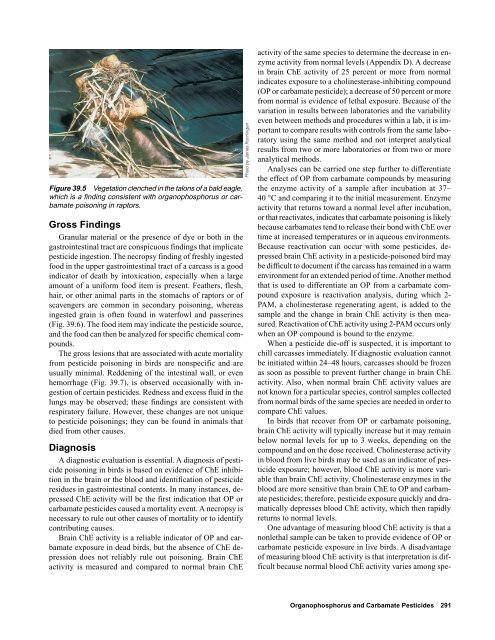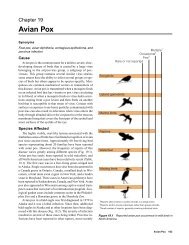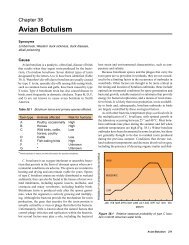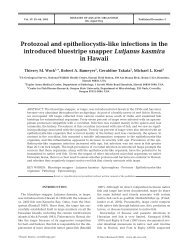Organophosphorus and carbamate pesticides - National Wildlife ...
Organophosphorus and carbamate pesticides - National Wildlife ...
Organophosphorus and carbamate pesticides - National Wildlife ...
Create successful ePaper yourself
Turn your PDF publications into a flip-book with our unique Google optimized e-Paper software.
Figure 39.5 Vegetation clenched in the talons of a bald eagle,<br />
which is a finding consistent with organophosphorus or <strong>carbamate</strong><br />
poisoning in raptors.<br />
Gross Findings<br />
Granular material or the presence of dye or both in the<br />
gastrointestinal tract are conspicuous findings that implicate<br />
pesticide ingestion. The necropsy finding of freshly ingested<br />
food in the upper gastrointestinal tract of a carcass is a good<br />
indicator of death by intoxication, especially when a large<br />
amount of a uniform food item is present. Feathers, flesh,<br />
hair, or other animal parts in the stomachs of raptors or of<br />
scavengers are common in secondary poisoning, whereas<br />
ingested grain is often found in waterfowl <strong>and</strong> passerines<br />
(Fig. 39.6). The food item may indicate the pesticide source,<br />
<strong>and</strong> the food can then be analyzed for specific chemical compounds.<br />
The gross lesions that are associated with acute mortality<br />
from pesticide poisoning in birds are nonspecific <strong>and</strong> are<br />
usually minimal. Reddening of the intestinal wall, or even<br />
hemorrhage (Fig. 39.7), is observed occasionally with ingestion<br />
of certain <strong>pesticides</strong>. Redness <strong>and</strong> excess fluid in the<br />
lungs may be observed; these findings are consistent with<br />
respiratory failure. However, these changes are not unique<br />
to pesticide poisonings; they can be found in animals that<br />
died from other causes.<br />
Diagnosis<br />
A diagnostic evaluation is essential. A diagnosis of pesticide<br />
poisoning in birds is based on evidence of ChE inhibition<br />
in the brain or the blood <strong>and</strong> identification of pesticide<br />
residues in gastrointestinal contents. In many instances, depressed<br />
ChE activity will be the first indication that OP or<br />
<strong>carbamate</strong> <strong>pesticides</strong> caused a mortality event. A necropsy is<br />
necessary to rule out other causes of mortality or to identify<br />
contributing causes.<br />
Brain ChE activity is a reliable indicator of OP <strong>and</strong> <strong>carbamate</strong><br />
exposure in dead birds, but the absence of ChE depression<br />
does not reliably rule out poisoning. Brain ChE<br />
activity is measured <strong>and</strong> compared to normal brain ChE<br />
Photo by James Runningen<br />
activity of the same species to determine the decrease in enzyme<br />
activity from normal levels (Appendix D). A decrease<br />
in brain ChE activity of 25 percent or more from normal<br />
indicates exposure to a cholinesterase-inhibiting compound<br />
(OP or <strong>carbamate</strong> pesticide); a decrease of 50 percent or more<br />
from normal is evidence of lethal exposure. Because of the<br />
variation in results between laboratories <strong>and</strong> the variability<br />
even between methods <strong>and</strong> procedures within a lab, it is important<br />
to compare results with controls from the same laboratory<br />
using the same method <strong>and</strong> not interpret analytical<br />
results from two or more laboratories or from two or more<br />
analytical methods.<br />
Analyses can be carried one step further to differentiate<br />
the effect of OP from <strong>carbamate</strong> compounds by measuring<br />
the enzyme activity of a sample after incubation at 37–<br />
40 °C <strong>and</strong> comparing it to the initial measurement. Enzyme<br />
activity that returns toward a normal level after incubation,<br />
or that reactivates, indicates that <strong>carbamate</strong> poisoning is likely<br />
because <strong>carbamate</strong>s tend to release their bond with ChE over<br />
time at increased temperatures or in aqueous environments.<br />
Because reactivation can occur with some <strong>pesticides</strong>, depressed<br />
brain ChE activity in a pesticide-poisoned bird may<br />
be difficult to document if the carcass has remained in a warm<br />
environment for an extended period of time. Another method<br />
that is used to differentiate an OP from a <strong>carbamate</strong> compound<br />
exposure is reactivation analysis, during which 2-<br />
PAM, a cholinesterase regenerating agent, is added to the<br />
sample <strong>and</strong> the change in brain ChE activity is then measured.<br />
Reactivation of ChE activity using 2-PAM occurs only<br />
when an OP compound is bound to the enzyme.<br />
When a pesticide die-off is suspected, it is important to<br />
chill carcasses immediately. If diagnostic evaluation cannot<br />
be initiated within 24–48 hours, carcasses should be frozen<br />
as soon as possible to prevent further change in brain ChE<br />
activity. Also, when normal brain ChE activity values are<br />
not known for a particular species, control samples collected<br />
from normal birds of the same species are needed in order to<br />
compare ChE values.<br />
In birds that recover from OP or <strong>carbamate</strong> poisoning,<br />
brain ChE activity will typically increase but it may remain<br />
below normal levels for up to 3 weeks, depending on the<br />
compound <strong>and</strong> on the dose received. Cholinesterase activity<br />
in blood from live birds may be used as an indicator of pesticide<br />
exposure; however, blood ChE activity is more variable<br />
than brain ChE activity. Cholinesterase enzymes in the<br />
blood are more sensitive than brain ChE to OP <strong>and</strong> <strong>carbamate</strong><br />
<strong>pesticides</strong>; therefore, pesticide exposure quickly <strong>and</strong> dramatically<br />
depresses blood ChE activity, which then rapidly<br />
returns to normal levels.<br />
One advantage of measuring blood ChE activity is that a<br />
nonlethal sample can be taken to provide evidence of OP or<br />
<strong>carbamate</strong> pesticide exposure in live birds. A disadvantage<br />
of measuring blood ChE activity is that interpretation is difficult<br />
because normal blood ChE activity varies among spe-<br />
<strong>Organophosphorus</strong> <strong>and</strong> Carbamate Pesticides 291
















